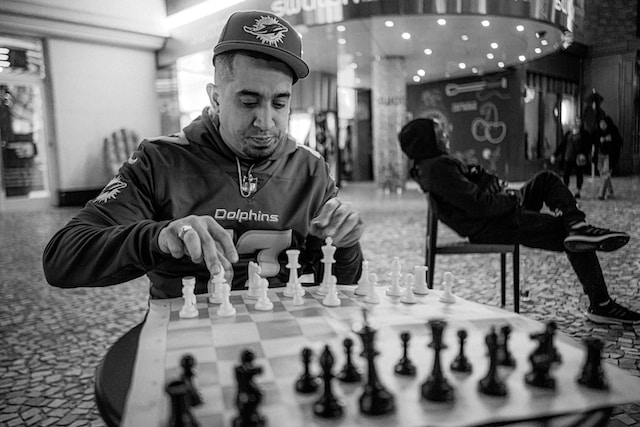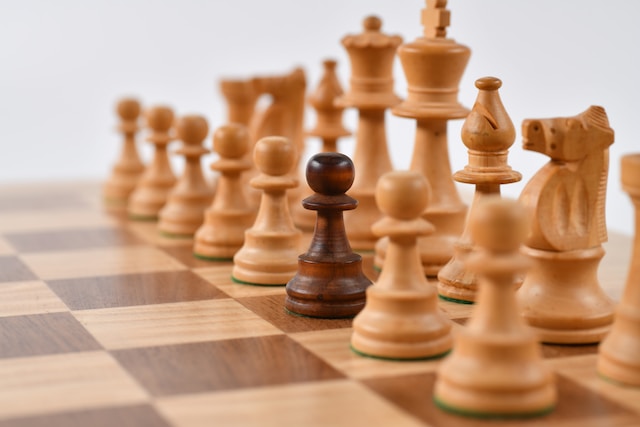Throughout history, chess has been revered as a metaphor for life, a battlefield where strategic thinking and decision-making skills are put to the test. It has been a source of inspiration for artists, philosophers, and strategists alike, symbolizing the eternal struggle between intellects.
In this guide, we will delve into the fundamentals of chess, exploring the basic rules, the movement and characteristics of each piece, and the objectives of the game. We will also touch upon essential concepts such as checkmate, stalemate, and the importance of controlling the center of the board. By understanding these foundations, you will be ready to embark on your chess journey with confidence.
So, whether you are a novice eager to learn the intricacies of the game or a seasoned player looking to deepen your understanding, this guide will provide you with a solid introduction to the world of chess. Get ready to sharpen your mind, and immerse yourself in the fascinating realm of this timeless game.
What is chess and why has it captivated minds for centuries?
Chess is a strategic board game played between two players on a checkered board divided into 64 squares. The game dates back centuries and has captivated minds across cultures and generations. Chess is known for its complexity and depth, requiring players to strategize, plan ahead, and think critically.
It is a game of pure intellect, where success hinges on mental acuity, foresight, and decision-making. The timeless appeal of chess lies in its combination of simplicity and endless possibilities. With a limited number of pieces and clear rules, chess offers a blank canvas for players to explore a multitude of strategies, tactics, and combinations. It challenges the mind, fuels creativity, and invites players to engage in a battle of wits that transcends time and cultural boundaries.

How does chess challenge the intellect?
Chess is renowned for its ability to challenge and stimulate the intellect. The game demands logical thinking, problem-solving skills, and the ability to analyze complex positions. Chess challenges players to think ahead, considering multiple possibilities and anticipating the opponent’s moves.
It encourages the development of cognitive skills such as critical thinking, pattern recognition, spatial awareness, and decision-making under pressure. Chess fosters strategic thinking by requiring players to formulate long-term plans, evaluate trade-offs, and adapt their strategies based on the changing dynamics of the game. Additionally, chess cultivates patience, discipline, and the capacity to learn from mistakes. The intellectual demands of chess make it not only a recreational pastime but also a tool for intellectual growth and development.

What are the fundamental components of a chessboard, and how does it contribute to the game of chess?
A chessboard consists of 64 squares arranged in an 8×8 grid. The squares alternate between light and dark colors, traditionally white and black. The chessboard serves as the arena for the game, providing the spatial framework where the pieces maneuver and interact. The layout of the chessboard facilitates strategic planning and visualization of moves.
It allows players to assess the positioning and control of various squares, lines, and diagonals. The checkered pattern aids in identifying patterns and formations on the board, aiding players in recognizing potential threats, and opportunities, and establishing piece coordination. The distinct arrangement of the chessboard is an essential visual and tactical element that shapes the dynamics and gameplay of chess.
Can you explain the unique abilities and movements of each chess piece on the board?
In chess, each piece has unique abilities and movements that contribute to the complexity of the game. The pieces include the king, queen, rooks, bishops, knights, and pawns. The king is the most vital piece, and its objective is to be protected at all costs. The queen is the most powerful piece, capable of moving in any direction along ranks, files, and diagonals.
Rooks move horizontally or vertically across the board, bishops move diagonally, and knights move in an L-shaped pattern. Pawns are the least powerful pieces but have the ability to promote to any other piece upon reaching the opponent’s back rank. Each piece brings different strategic opportunities, and players must utilize their unique movements to control the board, develop their positions, and create threats against the opponent.
| Chess Piece | Abilities | Key Points |
|---|---|---|
| King | Can move one square in any direction | Protect the king at all costs, avoid checkmate |
| Queen | Can move any number of squares in any direction | A versatile and powerful piece, ideal for attacks and defense |
| Rook | Can move any number of squares horizontally or vertically | Control open files and ranks, coordinate rooks for better effectiveness |
| Bishop | Can move any number of squares diagonally | Utilize bishops on opposite-colored squares for maximum coverage |
| Knight | Moves in an L-shape: two squares in one direction and then one square in a perpendicular direction | Knights are great for jumping over obstacles and launching surprise attacks |
What is the ultimate objective in chess, and how do you achieve checkmate to win the game?
The ultimate objective in chess is to achieve checkmate, which means placing the opponent’s king in a position where it is under attack and cannot escape capture. The player who checkmates their opponent’s king wins the game. Checkmate is achieved through a combination of strategic planning, tactical maneuvers, and positional play.
Players aim to develop their pieces harmoniously, control the center of the board, and create threats against the opponent’s king. By placing the opponent’s king in a vulnerable position with no legal moves to escape, checkmate is achieved, signaling the end of the game. Achieving checkmate requires foresight, calculation, and the ability to exploit weaknesses in the opponent’s position while defending one’s own king.
What strategies and techniques can be employed during the opening phase of a chess game to establish a strong position?
The opening phase of a chess game sets the stage for the ensuing battle, and players employ various strategies and techniques to establish a strong position. One common objective is to control the center of the board, as it provides a foundation for future development and allows for greater mobility of the pieces. Players often aim to develop their pieces harmoniously, bringing knights and bishops out to active squares while safeguarding their king.
Opening principles such as pawn structure, piece coordination, and rapid development are emphasized. Players may adopt established opening systems or employ lesser-known variations to surprise their opponents. They may also focus on controlling key squares, restricting the opponent’s piece mobility, and preparing for potential pawn breaks or tactical opportunities. By employing sound opening strategies, players can lay the groundwork for a solid position, ensuring a strong start to the game.

How do players navigate the complexities of the middle game and plan their moves ahead for optimal success?
The middle game in chess is a dynamic phase characterized by the full deployment of the pieces, increasing tactical possibilities, and strategic maneuvering. During this phase, players carefully assess the position, taking into account factors such as pawn structure, piece activity, king safety, and imbalances on the board.
They plan their moves ahead by identifying long-term goals, such as exploiting weak points in the opponent’s position, creating threats, or initiating a favorable pawn structure. Players often employ prophylactic moves to prevent the opponent’s plans and increase their own positional advantages.
They seek to seize control of open lines, outposts for their pieces, and central squares. Tactical calculations become crucial as players strive to uncover combinations or tactics that can shift the balance of the game in their favor. Navigating the complexities of the middle game requires a balance between proactive play and positional understanding, as players strive to execute moves that align with their overall strategic plan.
What is the significance of tactical brilliance in chess, and how can players unleash powerful moves and combinations?
Tactical brilliance plays a pivotal role in chess, often determining the outcome of a game. Tactics refer to short-term sequences of moves that exploit positional or material weaknesses to gain an advantage. Players strive to unleash powerful moves and combinations to seize the initiative, win material, or deliver a decisive blow.
Tactics can involve various motifs such as forks, pins, skewers, discovered attacks, and sacrifices. Recognizing tactical opportunities and calculating the consequences of moves accurately are crucial skills. Players train to spot tactical patterns, assess candidate moves, and calculate multiple moves ahead. Creating tactical threats forces opponents to respond, disrupting their plans and opening new possibilities. By employing tactical brilliance, players can turn the tide of a game, leading to decisive advantages or even swift victories.
How do players strategize and execute effective moves in the endgame phase to secure victory?
In the endgame phase of chess, with fewer pieces on the board, players strategize and execute moves with the aim of securing victory. Endgame strategy often revolves around pawn promotion, king activity, and the creation of passed pawns.
Players seek to centralize their king, activate their remaining pieces, and create favorable pawn structures to gain material or positional advantage. Key endgame concepts include king and pawn opposition, zugzwang, triangulation, and the technique of converting an advantage. Accurate calculation and the ability to assess the potential outcome of pawn races, exchanges, and pawn endgames become crucial.
Players employ various strategies, such as creating mating nets or exploiting weaknesses in the opponent’s pawn structure. Endgame mastery involves a deep understanding of theoretical endgames, precise calculation, and strategic decision-making to secure victory when the number of pieces on the board is reduced.
What are some defensive strategies and counterplay techniques that players can use to protect their pieces and turn the tide of the game?
In chess, defensive strategies and counterplay techniques are essential for protecting pieces and seizing opportunities to turn the tide of the game. Players employ a range of defensive techniques, such as creating solid pawn structures, fortifying key squares, and establishing defensive formations with their pieces.
They may prioritize piece safety and avoid unnecessary risks, opting for cautious moves that minimize vulnerabilities. Players can also use prophylactic moves to anticipate and neutralize the opponent’s threats before they materialize. Counterplay techniques involve actively seeking ways to challenge the opponent’s position and create threats of their own.
This can include launching tactical strikes, initiating piece exchanges, or exploiting weaknesses in the opponent’s structure. By combining defensive vigilance with strategic counterplay, players can protect their pieces, undermine the opponent’s plans, and shift the momentum of the game in their favor.
How does psychology play a role in chess, including mind games and psychological warfare between opponents?
Psychology plays a significant role in chess, affecting the players’ decision-making, mindset, and overall performance. Mind games and psychological warfare are subtle strategies employed to gain a mental edge over opponents. Psychological tactics involve creating ambiguity, introducing complications, and inducing time pressure to provoke mistakes.
Players may use psychological ploys such as unexpected moves, sacrifices, or strategic bluffing to unsettle their opponents and force them into poor decisions. Moreover, players can adopt psychological strategies to exploit their opponents’ strengths and weaknesses. They may choose openings or styles of play that challenge their opponent’s preferred setups or provoke them into making uncharacteristic mistakes.
Maintaining composure, resilience, and focus despite psychological pressures is vital. Recognizing and managing psychological factors can be as important as mastering the technical and strategic aspects of the game. Successful players understand the psychological dynamics at play and are adept at maintaining a balanced mindset while adapting to the mental challenges imposed by their opponents.
In General
Chess is a game that transcends time, captivating players across centuries and continents with its strategic depth and intellectual allure. Throughout this guide, we have explored the fundamentals of chess, from understanding the chessboard and its pieces to delving into advanced concepts and strategies.
Now, it is time to pick up the pieces and embark on your own chess odyssey. May your moves be bold, your strategies be cunning, and your love for the game continue to grow with each new encounter on the chessboard.
Checkmate!




